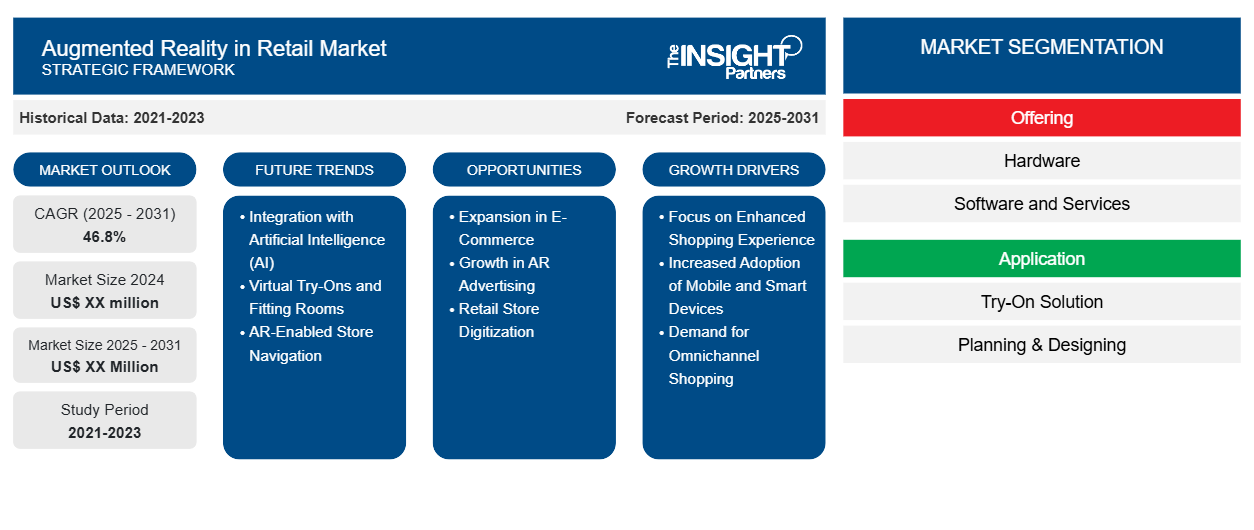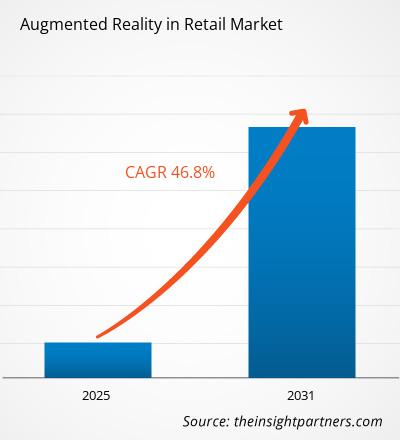The Augmented Reality in Retail Market is expected to register a CAGR of 46.8% from 2025 to 2031, with a market size expanding from US$ XX million in 2024 to US$ XX Million by 2031.
The report is segmented by Offering (Hardware, and Software and Services), Application (Try-On Solution, Planning & Designing, Others), Retail Type (Apparel, Beauty and Cosmetics, Furniture, Footwear, Others). The global analysis is further broken-down at regional level and major countries. The report offers the value in USD for the above analysis and segments
Purpose of the Report
The report Augmented Reality in Retail Market by The Insight Partners aims to describe the present landscape and future growth, top driving factors, challenges, and opportunities. This will provide insights to various business stakeholders, such as:
- Technology Providers/Manufacturers: To understand the evolving market dynamics and know the potential growth opportunities, enabling them to make informed strategic decisions.
- Investors: To conduct a comprehensive trend analysis regarding the market growth rate, market financial projections, and opportunities that exist across the value chain.
- Regulatory bodies: To regulate policies and police activities in the market with the aim of minimizing abuse, preserving investor trust and confidence, and upholding the integrity and stability of the market.
Augmented Reality in Retail Market Segmentation
Offering
- Hardware
- Software and Services
Application
- Try-On Solution
- Planning & Designing
Retail Type
- Apparel
- Beauty and Cosmetics
- Furniture
- Footwear
Geography
- North America
- Europe
- Asia Pacific
- Middle East and Africa
- South and Central America
You will get customization on any report - free of charge - including parts of this report, or country-level analysis, Excel Data pack, as well as avail great offers and discounts for start-ups & universities
Augmented Reality in Retail Market: Strategic Insights

-
Get Top Key Market Trends of this report.This FREE sample will include data analysis, ranging from market trends to estimates and forecasts.
Augmented Reality in Retail Market Growth Drivers
- Focus on Enhanced Shopping Experience: One of the primary drivers of the AR market in retail is the growing consumer demand for immersive, interactive, and personalized shopping experiences. AR enables consumers to visualize products in a real-world setting, whether it's trying on clothes virtually, visualizing furniture in their homes, or testing makeup. This interactive and engaging experience improves customer satisfaction, leading to increased conversion rates and higher sales. By creating a more dynamic shopping experience, retailers can differentiate themselves and stand out in a competitive market.
- Increased Adoption of Mobile and Smart Devices: The widespread use of smartphones and other mobile devices is fueling the growth of AR in retail. Most smartphones are equipped with the hardware required to support AR applications, making it accessible to a broad consumer base. Retailers can now reach consumers through their mobile apps or websites, allowing customers to use AR features on their phones to visualize products in their environment, scan barcodes for product details, or interact with ads in a more engaging way. As more consumers adopt smart devices, the potential for AR in retail will continue to grow.
- Demand for Omnichannel Shopping: As consumers increasingly expect a seamless shopping experience across online and offline channels, AR technology is becoming a vital tool in helping retailers bridge the gap. With AR, customers can explore products in physical stores while having access to detailed product information, virtual try-ons, and other interactive features via their smartphones or smart glasses. Additionally, AR helps retailers bring their physical stores to life online, allowing users to visualize items in their own homes before making a purchase. This integration of online and in-store shopping enhances the overall consumer experience, making it more convenient and enjoyable.
Augmented Reality in Retail Market Future Trends
- Integration with Artificial Intelligence (AI): The future of AR in retail will be increasingly shaped by the integration of artificial intelligence (AI). Combining AR with AI technologies allows retailers to create even more personalized and intelligent shopping experiences. For example, AI algorithms can analyze customer data to offer tailored product recommendations, while AR can help visualize those recommendations in real-time. In addition, AI-powered AR can enhance virtual try-on experiences, making them more accurate and lifelike. This fusion of AR and AI will be pivotal in the future of retail as it enhances customer interaction and helps brands build deeper connections with shoppers.
- Virtual Try-Ons and Fitting Rooms: Virtual try-ons, enabled by AR, are revolutionizing the retail sector, especially in fashion, cosmetics, and eyewear. Consumers can use their smartphones, tablets, or AR glasses to see how clothes, makeup, or glasses look on them without trying them on physically. This technology has already been successfully adopted by brands like Sephora, L'Oreal, and IKEA. As AR technology becomes more sophisticated, virtual try-on experiences will become even more realistic and intuitive, increasing their adoption in various sectors. The future will likely see AR try-ons in more categories, including footwear, jewelry, and home decor.
- AR-Enabled Store Navigation: In large retail spaces, such as department stores or malls, AR can provide customers with an enhanced shopping experience by helping them navigate the store and find products more easily. Using AR-enabled smartphones or in-store AR kiosks, customers can receive directions to specific items, view detailed product information, and find promotions. This feature will help customers save time and make their shopping experience more efficient. As retail spaces evolve, store navigation powered by AR will become a common tool to enhance in-store experiences.
Augmented Reality in Retail Market Opportunities
- Expansion in E-Commerce: The e-commerce sector presents significant growth opportunities for AR in retail. As online shopping continues to dominate, retailers can use AR to bridge the gap between virtual and physical shopping experiences. Features like virtual try-ons, 3D product visualizations, and AR-powered product demonstrations are helping e-commerce platforms offer a more interactive and engaging experience. This provides a competitive advantage, especially for brands looking to differentiate themselves in a crowded marketplace. As AR technology evolves, more e-commerce brands will likely incorporate AR features to improve the online shopping experience and reduce return rates.
- Growth in AR Advertising: Augmented reality advertising offers brands a new way to engage consumers with creative, interactive content. From AR billboards and print ads to mobile app-based experiences, retailers can use AR to create dynamic and memorable advertising campaigns. This immersive advertising helps brands capture attention and create a lasting impression. As AR technology becomes more mainstream, advertising opportunities using AR will expand, and brands will increasingly invest in these innovative marketing strategies to stand out.
- Retail Store Digitization: Brick-and-mortar retailers are investing in digital transformation, and AR is playing a pivotal role in this process. Retailers are implementing AR-powered store experiences, such as interactive displays, digital signage, and personalized in-store recommendations. These innovations not only enhance the customer experience but also drive foot traffic to physical stores. As consumers become more accustomed to digital experiences, the use of AR in physical retail spaces will increase, creating more opportunities for retailers to enhance their offerings and engage with shoppers.
Augmented Reality in Retail Market Regional Insights
The regional trends and factors influencing the Augmented Reality in Retail Market throughout the forecast period have been thoroughly explained by the analysts at The Insight Partners. This section also discusses Augmented Reality in Retail Market segments and geography across North America, Europe, Asia Pacific, Middle East and Africa, and South and Central America.
Augmented Reality in Retail Market Report Scope
| Report Attribute | Details |
|---|---|
| Market size in 2024 | US$ XX million |
| Market Size by 2031 | US$ XX Million |
| Global CAGR (2025 - 2031) | 46.8% |
| Historical Data | 2021-2023 |
| Forecast period | 2025-2031 |
| Segments Covered |
By Offering
|
| Regions and Countries Covered |
North America
|
| Market leaders and key company profiles |
|
Augmented Reality in Retail Market Players Density: Understanding Its Impact on Business Dynamics
The Augmented Reality in Retail Market is growing rapidly, driven by increasing end-user demand due to factors such as evolving consumer preferences, technological advancements, and greater awareness of the product's benefits. As demand rises, businesses are expanding their offerings, innovating to meet consumer needs, and capitalizing on emerging trends, which further fuels market growth.

- Get the Augmented Reality in Retail Market top key players overview
Key Selling Points
- Comprehensive Coverage: The report comprehensively covers the analysis of products, services, types, and end users of the Augmented Reality in Retail Market, providing a holistic landscape.
- Expert Analysis: The report is compiled based on the in-depth understanding of industry experts and analysts.
- Up-to-date Information: The report assures business relevance due to its coverage of recent information and data trends.
- Customization Options: This report can be customized to cater to specific client requirements and suit the business strategies aptly.
The research report on the Augmented Reality in Retail Market can, therefore, help spearhead the trail of decoding and understanding the industry scenario and growth prospects. Although there can be a few valid concerns, the overall benefits of this report tend to outweigh the disadvantages.
Frequently Asked Questions
What are the options available for the customization of this report?
What are the deliverable formats of the augmented reality in retail market report?
What are the future trends of augmented reality in retail market?
What are the driving factors impacting global augmented reality in retail market?
What is the expected CAGR of augmented reality in retail market?
- Historical Analysis (2 Years), Base Year, Forecast (7 Years) with CAGR
- PEST and SWOT Analysis
- Market Size Value / Volume - Global, Regional, Country
- Industry and Competitive Landscape
- Excel Dataset
Recent Reports
Testimonials
Reason to Buy
- Informed Decision-Making
- Understanding Market Dynamics
- Competitive Analysis
- Identifying Emerging Markets
- Customer Insights
- Market Forecasts
- Risk Mitigation
- Boosting Operational Efficiency
- Strategic Planning
- Investment Justification
- Tracking Industry Innovations
- Aligning with Regulatory Trends






















 Get Free Sample For
Get Free Sample For